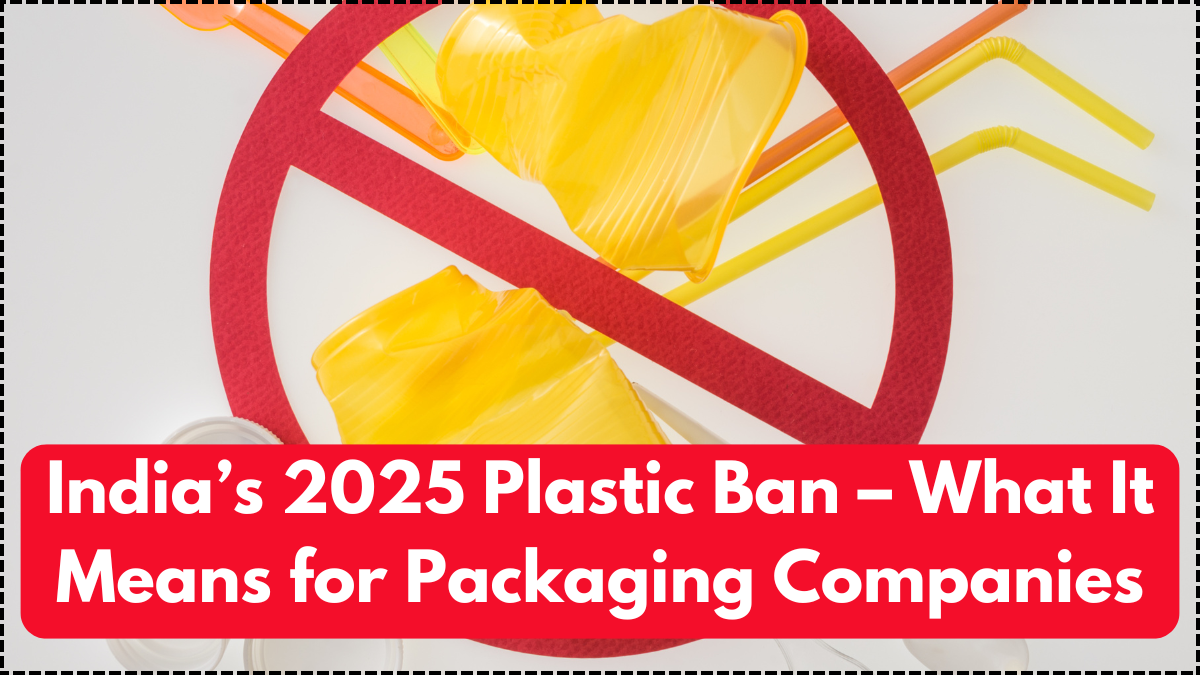India has taken a decisive leap in environmental regulation with the announcement of the Plastic Ban 2025 India. The ban targets a wide range of single-use plastic items and imposes stricter controls on manufacturing, distribution, and disposal. This bold move aims to combat the country’s growing plastic pollution crisis and has significant industry impact, especially on packaging companies across various sectors.
As the world grapples with climate change and oceanic pollution, India’s government is accelerating its commitment to sustainable development. The new policy, introduced by the Ministry of Environment, Forest and Climate Change, outlines a phased approach to phasing out certain plastic categories while promoting eco-friendly alternatives. Businesses, especially in FMCG, e-commerce, and food delivery sectors, must now revisit their packaging strategies to align with these new rules.

What Does the Plastic Ban 2025 India Cover?
The Plastic Ban 2025 India prohibits the manufacture, sale, and use of a wide array of plastic products that are deemed non-essential and hard to recycle. The ban is being implemented in stages to give industries time to adapt and innovate.
Key items banned include:
- Single-use plastic cutlery, plates, and straws
- Polystyrene (thermocol) for decoration and packaging
- Plastic carry bags below 75 microns
- Multi-layer plastic wrappers not recyclable
- Sachets for storing liquid or semi-liquid products
The new law also mandates Extended Producer Responsibility (EPR), meaning companies must take back used packaging materials and ensure their safe disposal or recycling.
How the Ban Impacts the Packaging Industry
The industry impact of the Plastic Ban 2025 India is most profound in sectors that rely heavily on inexpensive, lightweight, and disposable plastic packaging. Businesses now face a dual challenge: compliance with regulation and managing operational costs.
Major impacts on the industry:
- Increased cost of alternative eco-packaging
- Supply chain disruption due to material shift
- Need for R&D investment in biodegradable or recyclable solutions
- Greater demand for sustainable raw materials
- Shift in consumer packaging preferences
Many companies have already begun piloting biodegradable materials, edible packaging, or recyclable paper-based designs in anticipation of the new rules.
Government Incentives and Industry Adaptation
Understanding the economic implications, the Indian government is offering incentives to help industries transition. Special funds, tax rebates, and subsidies are being made available for companies investing in sustainable packaging solutions.
Here is a table summarizing some government initiatives to support the transition:
| Initiative | Description | Target Beneficiaries |
|---|---|---|
| Green Packaging Innovation Fund | ₹1,000 crore for R&D in eco-packaging | MSMEs, startups |
| Tax Incentives | GST reduction on biodegradable packaging materials | All registered packaging firms |
| Technology Transfer Hubs | Shared infrastructure for material testing & design | State-run industrial parks |
| Compliance Credit Points | Points-based system to reward compliant businesses | E-commerce & food delivery firms |
These initiatives reflect the government’s intent to ensure the industry impact is met with practical support, not just regulations.
Consumer Behavior and Market Trends
The success of the Plastic Ban 2025 India will largely depend on public participation and changing consumer behavior. The rise of eco-conscious consumers is already driving demand for sustainable products, and packaging trends are quickly evolving.
New consumer expectations include:
- Reusable or recyclable packaging
- Minimalistic and biodegradable designs
- Clear labeling of disposal instructions
- Avoidance of over-packaging
Brands that align with these preferences stand to gain a competitive edge while also supporting environmental conservation goals.
Conclusion
The Plastic Ban 2025 India marks a major milestone in the country’s environmental policy and comes with sweeping industry impact. Packaging companies must now innovate, adapt, and collaborate to stay ahead. While the transition may appear daunting, it also opens doors for new technologies, greener branding, and long-term cost savings. With government backing and growing consumer support, the shift away from plastic can become a business opportunity rather than a burden.
FAQs
What types of plastics are banned under the Plastic Ban 2025 India?
Items like single-use cutlery, thin plastic bags, polystyrene, and non-recyclable multi-layered packaging are banned.
How does the ban affect the packaging industry?
It forces packaging companies to switch to sustainable alternatives, increasing costs but also creating innovation opportunities.
Are there government incentives for companies transitioning to green packaging?
Yes, there are tax benefits, innovation grants, and support hubs available for packaging industries investing in eco-friendly alternatives.
Is Extended Producer Responsibility (EPR) mandatory?
Yes, under the new policy, companies must manage the waste generated from their packaging by collecting and recycling it.
Will consumers have to pay more due to this ban?
Initially, there might be a slight cost increase, but prices are expected to stabilize as eco-friendly options become mainstream.
Click here to know more